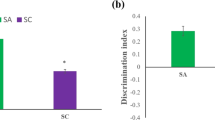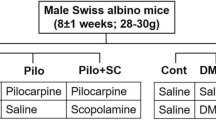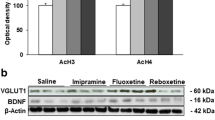Abstract
Recently, we reported a correlation of scopolamine mediated decline in memory consolidation with increase in the expression of DNA methyltransferase 1 (DNMT1) and histone deacetylase 2 (HDAC2) in the mouse hippocampus. Memory consolidation is a protein synthesis-dependent process which involves the expression of synaptic plasticity genes, particularly neuronal immediate early genes (IEGs). However, the mechanism of regulation of these genes during decline in memory is poorly understood. Therefore, we have studied the epigenetic regulation of expression of neuronal IEGs in scopolamine-induced amnesic mice. Scopolamine significantly impaired memory consolidation as tested by radial arm maze, and the expression of neuronal IEGs was downregulated in the hippocampus as revealed by qRT-PCR and Western blotting. Further, methylated DNA immunoprecipitation (MeDIP) analysis showed increase in DNA methylation, while chromatin immunoprecipitation (ChIP) revealed decrease in H3K9/14 acetylation at the promoter of neuronal IEGs. Taken together, the present study shows that increased DNA methylation and decreased histone acetylation at the promoter of neuronal IEGs are associated with decline in their expression and memory consolidation during scopolamine-induced amnesia. These findings suggest that the epigenetic regulation through altered DNA methylation and histone acetylation might be explored further to develop potential therapeutic interventions for amnesia.





Similar content being viewed by others
Change history
24 July 2019
The original article inadvertently had a mistake in Fig.��3a and b. The authors regret to these errors.
24 July 2019
The original article inadvertently had a mistake in Fig.��3a and b. The authors regret to these errors.
References
Liu L, Groen TV, Kadish I, Tollefsbol TO (2009) DNA methylation impacts on learning and memory in aging. Neurobiol aging 30:549–560
Moore LD, Le T, Fan G (2012) DNA methylation and its basic function. Neuropsychopharmacology Rev 38:23–38
Lu H, Liu X, Deng Y, Qing H (2013) DNA methylation, a hand behind neurodegenerative diseases. Front aging neurosci. doi:10.3389/fnagi.2013.00085
Penner MR, Roth TL, Chawla MK, Hoanga LT, Roth ED, Lubin FD, Sweatt JD, Worley PF, et al. (2011) Age-related changes in Arc transcription and DNA methylation within the hippocampus. Neurobiol Aging 32:2198–2210
Orphanides G, Reinberg D (2002) A unified theory of gene expression. Cell 108:439–451
Guan JS, Haggarty SJ, Giacometti E, Dannenberg JH, Joseph N, Gao J, Nieland TJF, Zhou Y, et al. (2009) HDAC2 negatively regulates memory formation and synaptic plasticity. Nature 459:55–60
Morris MJ, Mahgoub M, Na ES, Pranav H, Monteggia LM (2013) Loss of histone deacetylase 2 improves working memory and accelerates extinction learning. J Neurosci 33:6401–6411
Abel T, Lattal KM (2001) Molecular mechanisms of memory acquisition, consolidation and retrieval. Curr Opin Neurobiol 11:180–187
Davis S, Bozon B, Laroche S (2003) How necessary is the activation of the immediate early gene zif268 in synaptic plasticity and learning? Behav Brain Res 142:17–30
Miyashita T, Kubik S, Lewandowski G, Guzowski JF (2008) Networks of neurons, networks of genes: an integrated view of memory consolidation. Neurobiol Learn Mem 89:269–284
Minatohara K, Akiyoshi M, Okuno H (2016) Role of immediate-early genes in synaptic plasticity and neuronal ensembles underlying the memory trace. Front Mol Neurosci. doi:10.3389/fnmol.2015.00078
Guzowski JF (2002) Insights into immediate-early gene function in hippocampal memory consolidation using antisense oligonucleotide and fluorescent imaging approaches. Hippocampus 12:86–104
Loebrich S, Nedivi E (2009) The function of activity-regulated genes in the nervous system. Physiol Rev 89:1079–1103
Jones MW, Errington ML, French PJ, Fine A, Bliss TVP, Garel S, Charnay P, Bozon B, et al. (2001) A requirement for the immediate early gene zif268 in the expression of late LTP and long-term memories. Nature Neurosci 4:289–296
Tzingounis A, Nicoll RA (2006) Arc/Arg3.1: linking gene expression to synaptic plasticity and memory. Neuron 52:403–407
Bramham CR, Worley PF, Moore MJ, Guzowski JF (2008) The immediate early gene arc/arg3.1: regulation, mechanisms, and function. J Neurosci 28:11760–11767
Reti IM, Reddy R, Worley PF, Baraban JM (2002) Selective expression of Narp, a secreted neuronal pentraxin, in orexin neurons. J Neurochem 82:1561–1565
Johnson AW, Crombag HS, Takamiya K, Baraban JM, Holland PC, Huganir RL, Reti IM (2007) A selective role for neuronal activity regulated pentraxin in the processing of sensory-specific incentive value. J Neurosci 27:13430–13435
Brouillette J, Young D, During MJ, Quirion R (2007) Hippocampal gene expression profiling reveals the possible involvement of Homer1 and GABAB receptors in scopolamine-induced amnesia. J Neurochem 102:1978–1989
Konar A, Shah N, Singh R, Saxena N, Kaul SC, Wadhwa R, Thakur MK (2011) Protective role of Ashwagandha leaf extract and its component withanone on scopolamine-induced changes in the brain and brain-derived cells. PloS One. doi:10.1371/journal.pone.0027265
Gautam A, Wadhwa R, Thakur MK (2013) Involvement of hippocampal Arc in amnesia and its recovery by alcoholic extract of Ashwagandha leaves. Neurobiol Learn Mem 106:177–184
Singh P, Konar A, Kumar A, Srivas S, Thakur MK (2015) Hippocampal chromatin modifying enzymes are pivotal for scopolamine-induced synaptic plasticity gene expression changes and memory impairment. J Neurochem 134:642–651
Valladolid-Acebes I, Stucchi P, Cano V, Fernandez-Alfonso MS, Merino B, Gil-Ortega M, Fole A, Morales L, et al. (2011) High-fat diets impair spatial learning in the radial-arm maze in mice. Neurobiol learn mem 95:80–85
Nikbakht N, Zarei B, Shirani E, Moshtaghian J, Esmaeili A, Habibian S (2012) Experience-dependent expression of rat hippocampal Arc and Homer1a after spatial learning on 8-arm and 12-arm radial mazes. Neuroscience 218:49–55
Ziolkowska B, Urbanski MJ, Wawrzczak-Bargiela A, Bilecki W, Przewlocki R (2005) Morphine activates Arc expression in the mouse striatum and in mouse neuroblastoma Neuro2A MOR1A cells expressing mu-opioid receptors. J Neurosci Res 82:563–570
Kidambi S, Yarmush J, Berdichevsky Y, Kamath S, Fong W, SchianodiCola J (2010) Propofol induces MAPK/ERK cascade dependant expression of cFos and Egr-1 in rat hippocampal slices. BMC Res Notes 3:201
Mahan AL, Mou L, Shah N, Hu JH, Worley PF, Ressler KJ (2012) Epigenetic modulation of Homer1a transcription regulation in amygdala and hippocampus with pavlovian fear conditioning. J Neurosci 32:4651–4659
Konar A, Thakur MK (2015) Neuropsin expression correlates with dendritic marker MAP2c level in different brain regions of aging mice. Mol Neurobiol 51:1130–1138
Watts J, Stevens R, Robinson C (1981) Effects of scopolamine on radial maze performance in rats. Physiol Behav 26:845–851
Zhang HT, O’Donnell JM (2000) Effects of rolipram on scopolamine-induced impairment of working and reference memory in the radial-arm maze tests in rats. Psychopharmacology 150:311–316
Rai R, Singh HK, Prasad S (2015a) special extract of bacopa monnieri (cdri-08) restores learning and memory by upregulating expression of the NMDA receptor subunit GluN2B in the brain of scopolamine-induced amnesic mice. Evid Based Complement Alternat Med 2015:254303. doi:10.1155/2015/254303
Nadel L, Moscovitch M (1997) Memory consolidation, retrograde amnesia and the hippocampal complex. Curr Opin Neurobiol 7:217–227
Glick SD, Zimmerberg B (1972) Amnesic effects of scopolamine. Behav Biol 7:245–254
Ghoneim MM, Mewaldt SP (1975) Effects of diazepam and scopolamine on storage, retrieval and organizational processes in memory. Psychopharmacologia 44:257–226
Izquierdo I (1989) Mechanism of action of scopolamine as an amnestic. Trends Pharmacol Sci 10:175–177
Wallenstein GV, Vago DR (2001) Intrahippocampal scopolamine impairs both acquisition and consolidation of contextual fear conditioning. Neurobiol Learn Mem 75:245–252
Rutten K, Prickaerts J, Blokland A (2006) Rolipram reverses scopolamine-induced and time-dependent memory deficits in object recognition by different mechanisms of action. Neurobiol Learn Mem 85:132–138
Han CK, Park YH, Jin DQ, Hwang YK, Oh KB, Han JS (2007) SK-PC-B70M from Pulsatilla koreana improves scopolamine-induced impairments of memory consolidation and spatial working memory. Brain Res 1184:254–259
Klinkenberg I, Blokland A (2010) The validity of scopolamine as a pharmacological model for cognitive impairment: a review of animal behavioral studies. Neurosci Biobehav Rev 34:1307–1350
Schliebs R, Arendt T (2011) The cholinergic system in aging and neuronal degeneration. Behav Brain Res 221:555–563
Tata AM, Velluto L, D'Angelo C, Reale M (2014) Cholinergic system dysfunction and neurodegenerative diseases: cause or effect? CNS Neurol Disord Drug Targets 13:1294–1303
Morgan D, Diamond DM, Gottschall PE, Ugen KE, Dickey C, Hardy J, Duff K, Jantzen P, et al. (2000) A beta peptide vaccination prevents memory loss in an animal model of Alzheimer’s disease. Nature 408:982–985
Oler JA, Markur EJ (1998) Age-related deficits on the radial maze and in fear conditioning: hippocampal processing and consolidation. Hippocampus 8:402–415
Shukitt-Hale B, McEwen JJ, Szprengiel A, Joseph JA (2004) Effect of age on the radial arm water maze—a test of spatial learning and memory. Neurobiol aging 25:223–229
Borlikova GG, Trejo M, Mably AJ, Mc Donald JM, SalaFrigerio C, Regan CM, Murphy KJ, Masliah E, et al. (2013) Alzheimer brain-derived amyloid β-protein impairs synaptic remodeling and memory consolidation. Neurobiol Aging 34:1315–1327
Singh P, Thakur MK (2014) Reduced recognition memory is correlated with decrease in DNA methyltransferase1 and increase in histone deacetylase2 protein expression in old male mice. Biogerontology 15:339–346
Kumari A, Thakur MK (2014) Age-dependent decline of nogo—a protein in the mouse cerebrum. Cell Mol Neurobiol 34:1131–1141
Kumar D, Thakur MK (2014) Age-related expression of Neurexin1 and Neuroligin3 is correlated with presynaptic density in the cerebral cortex and hippocampus of male mice. Age 37:17
Konar A, Gautam A, Thakur MK (2015) Bacopa monniera (cdri-08) upregulates the expression of neuronal and glial plasticity markers in the brain of scopolamine induced amnesic mice. Evid Based Complement Alternat Med 2015:837012. doi:10.1155/2015/837012
Konar A, Singh P, Thakur MK (2015) Age-associated cognitive decline: insights into molecular switches and recovery avenues. Aging Dis. doi:10.14336/AD.2015.1004
Okuno H (2011) Regulation and function of immediate-early genes in the brain: beyond neuronal activity markers. Neurosci Res 69:175–186
Korb E, Finkbeiner S (2011) Arc in synaptic plasticity: from gene to behavior. Cell 34:11
Palop JJ, Chin J, Bien-Ly N, Massaro C, Yeung BZ, Yu GQ, Mucke L (2005) Vulnerability of dentate granule cells to disruption of arc expression in human amyloid precursor protein transgenic mice. J Neurosci 25:9686–9693
Gautam A, Kaul SC, Thakur MK (2015) Alcoholic extract of Ashwagandha leaves protects against amnesia by regulation of Arc function. Mol Neurobiol. doi:10.1007/s12035-015-9117-2
Maddox SA, Monsey MS, Schafe GE (2011) Early growth response gene 1 (Egr-1) is required for new and reactivated fear memories in the lateral amygdale. Learn Mem 18:24–38
Bozon B, Kelly A, Josselyn SA, Silva AJ, Davis S, Laroche S (2003) MAPK, CREB and zif268 are all required for the consolidation of recognition memory. Phil Trans Royal Soc Lon 358:805–814
Hall J, Thomas KL, Everitt BJ (2001) Cellular imaging of zif268 expression in the hippocampus and amygdala during contextual and cued fear memory retrieval: selective activation of hippocampal CA1 neurons during the recall of contextual memories. J Neurosci 21:2186–2193
Lee JLC, Everitt BJ, Thomas KL (2004) Independent cellular processes for hippocampal memory consolidation and reconsolidation. Science 304:839–843
Koldamova R, Schug J, Lefterova M, Cronican AA, Fitz NF, Davenport FA, Carter A, Castranio EL, et al. (2014) Genome-wide approaches reveal EGR1-controlled regulatory networks associated with neurodegeneration. Neurobiol Dis 63:107–114
Desjardins S, Mayo W, Vallee M, Hancock D, Moal ML, Simon H, Abrous DN (1997) Effect of aging on the basal expression of c-Fos, c-Jun, and Egr-1 proteins in the hippocampus. Neurobiol Aging 18:37–44
Wang X, Wang ZH, Wu YY, Tang H, Tan L, Wang X, Gao XY, Xiong YS, et al. (2013) Melatonin attenuates scopolamine-induced memory/synaptic disorder by rescuing EPACs/miR-124/Egr1 pathway. Mol Neurobiol 47:373–381
Brakeman PR, Lanahan AA, O'brien R, Roche K, Barnes CA, Huganir RL, Worley PF (1997) Homer: a protein that selectively binds metabotropic glutamate receptors. Nature 386:284–288
Luo P, Li X, Fei Z, Poon W (2012) Scaffold protein Homer 1: implications for neurological diseases. Neurochem Int 61:731–738
Szumlinski KK, Lominac KD, Kleschen MJ, Oleson EB, Dehoff MH, Schwartz MK, Seeberg PJ, Worley PF, et al. (2005) Behavioral and neurochemical phenotyping of Homer1 mutant mice: possible relevance to schizophrenia. Genes Brain Behav 4:273–288
Wagner KV, Hartmann J, Mangold K, Wang XD, Labermaier C, Liebl C, Wolf M, Gassen NC, et al. (2013) Homer1 mediates acute stress-induced cognitive deficits in the dorsal hippocampus. J Neurosci 33:3857–3864
O'Brien RJ, Xu D, Petralia RS, Steward O, Huganir RL, Worley P (1991) Synaptic clustering of AMPA receptors by the extracellular immediate-early gene product Narp. Neuron 23:309–323
Blalock EM, Chen KC, Sharrow K, Herman JP, Porter NM, Foster TC, Landfield PW (2003) Gene microarrays in hippocampal aging: statistical profiling identifies novel processes correlated with cognitive impairment. J Neurosci 23:3807–3819
Levenson JM, Sweatt JD (2006) Epigenetic mechanisms: a common theme in vertebrate and invertebrate memory formation. Cell Mol Life Sci 63:1009–1016
Lahiri DK, Maloney B, Zawia NH (2009) The LEARn model: an epigenetic explanation for idiopathic neurobiological diseases. Mol Psychiatry 14:992–1003
Irvine RA, Lin IG, Hsieh CL (2002) DNA methylation has a local effect on transcription and histone acetylation. Mol Cell Biol 22:6689–6696
Roth TL, Sweatt JD (2009) Regulation of chromatin structure in memory formation. Curr Opin Neurobiol 19:336–342
Levenson JM, Roth T, Lubin FD, Miller CA, Huang IC, Desai P, Malone LM, Sweatt JD (2006) Evidence that DNA (Cytosine-5) methyltransferase regulates synaptic plasticity in the hippocampus. J Biol Chem 281:15763–15773
Miller CA, Sweatt JD (2007) Covalent modification of DNA regulates memory formation. Neuron 53:857–869
Lubin FD, Roth TL, Sweatt JD (2008) Epigenetic regulation of BDNF gene transcription in the consolidation of fear memory. J Neurosci 28:10576–10586
Day JJ, Sweatt JD (2011) Epigenetic modifications in neurons are essential for formation and storage of behavioral memory. Neuropsychopharmacology 36:357–358
Ikegame T, Bundo M, Sunaga F, Asai T, Nishimura F, Yoshikawa A, Kawamura Y, Hibino H, et al. (2013) DNA methylation analysis of BDNF gene promoters in peripheral blood cells of schizophrenia patients. Neurosci Res 77:208–214
Robertson KD (2002) DNA methylation and chromatin—unraveling the tangled web. Oncogene 21:5361–5379
Irvine RA, Lin IG, Hsieh CL (2002) DNA methylation has a local effect on transcription and histone acetylation. Mol Cell Biol 22:6689–6696
Turner BM (2000) Histone acetylation and an epigenetic code. Bioessays 22:836–845
Federman N, Fustinana MS, Romano A (2009) Histone acetylation is recruited in consolidation as a molecular feature of stronger memories. Learn Mem 16:600–606
Peleg S, Sananbenesi F, Zovoilis A, Burkhardt S, Bahari-Javan S, Agis-Balboa RC, Cota P, Wittnam JL, et al. (2010) Altered histone acetylation is associated with age-dependent memory impairment in mice. Science 328:753–756
Fischer A, Sananbenesi F, Wang X, Dobbin M, Tsai LH (2007) Recovery of learning and memory is associated with chromatin remodeling. Nature 447:178–182
Bousiges O, Vasconcelos AP, Neidl R, Cosquer B, Herbeaux K, Panteleeva I, Loeffler JP, Cassel JC, et al. (2010) Spatial memory consolidation is associated with induction of several lysine-acetyltransferase (histone acetyltransferase) expression levels and H2B/H4 acetylation-dependent transcriptional events in the rat hippocampus. Neuropsychopharmacology 35:2521–2537
Zhang K, Schrag M, Crofton A, Trivedi R, Vinters H, Kirsch W (2012) Targeted proteomics for quantification of histone acetylation in Alzheimer’s disease. Proteomics 12:1261–1268
Hendrickx A, Pierrot N, Tasiaux B, Schakman O, Kienlen-Campard P, Smet CD, Octave JN (2014) Expression regulation of immediate early genes expression involved in memory formation by the amyloid precursor protein of Alzheimer disease. Plos One. 9:e99467
Acknowledgments
This work was supported by the Department of Biotechnology, Ministry of Science and Technology (BT/PR3996/MED/97/57/2011), Government of India. We also acknowledge the University Grants Commission, India, for senior research fellowship to S.S. and DBT-BHU Interdisciplinary School of Life Sciences, Banaras Hindu University, for the use of real-time PCR, cryotome, and confocal microscopy facility.
Author information
Authors and Affiliations
Corresponding author
Ethics declarations
Conflict of Interest
The authors declare that they have no conflict of interest.
Electronic supplementary material
Figure 1.
Diagrammatic representation of promoter regions of Arc, Egr1, Homer1 and Narp amplified by qPCR. The green region represents the promoter region amplified for MeDIP and ChIP qPCR assay. (TSS- Transcription start site). (GIF 1176 kb)
Rights and permissions
About this article
Cite this article
Srivas, S., Thakur, M.K. Epigenetic regulation of neuronal immediate early genes is associated with decline in their expression and memory consolidation in scopolamine-induced amnesic mice. Mol Neurobiol 54, 5107–5119 (2017). https://doi.org/10.1007/s12035-016-0047-4
Received:
Accepted:
Published:
Issue Date:
DOI: https://doi.org/10.1007/s12035-016-0047-4




